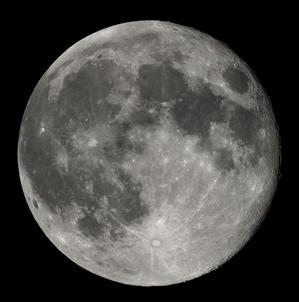Glossary term: Lunar Phase
Redirected from Full Moon
Description: Lunar phase refers to the Moon's position in its orbit around the Earth. The changing position the Moon causes the changing shape of the illuminated portion of the Moon visible from Earth over the course of one lunar month. Half of the Moon is always, apart from during lunar eclipses, illuminated by the Sun. On Earth we see different parts of the Moon illuminated as it moves in its orbit around us. The lunar month starts and ends at the same phase. At a phase of 0 degrees, called "new moon," the Moon is as close to the Sun as it will be on that orbit. At that phase, the illuminated side of the Moon faces away from Earth, and the Moon appears dark. The size of the illuminated part of the Moon gradually increases (waxing phase) becoming a crescent. The first quarter phase (when half of the moon appears to be illuminated, this is popularly known as half moon) occurs at 90 degrees from the start point. The illuminated portion of the Moon continues to increase, becoming gibbous (convex-shaped, or bulging-shaped). Full moon occurs at 180 degrees. After this point, the shape gradually starts decreasing (waning phase), resulting in a gibbous moon, the last quarter phase (when half of the moon appears to be illuminated, this is popularly known as half moon) at 270 degrees from the start, the crescent moon, and ending as a new moon at 360 degrees. Even though half the Moon appears illuminated at phases 90 and 270 degrees, the opposite sides are the ones illuminated.
Related Terms:
See this term in other languages
Term and definition status: This term and its definition have been approved by a research astronomer and a teacher
The OAE Multilingual Glossary is a project of the IAU Office of Astronomy for Education (OAE) in collaboration with the IAU Office of Astronomy Outreach (OAO). The terms and definitions were chosen, written and reviewed by a collective effort from the OAE, the OAE Centers and Nodes, the OAE National Astronomy Education Coordinators (NAECs) and other volunteers. You can find a full list of credits here. All glossary terms and their definitions are released under a Creative Commons CC BY-4.0 license and should be credited to "IAU OAE".
If you notice a factual error in this glossary definition then please get in touch.
Related Media
Full moon
Credit: Luc Viatour credit link
License: CC-BY-SA-3.0 Creative Commons Attribution-ShareAlike 3.0 Unported icons









